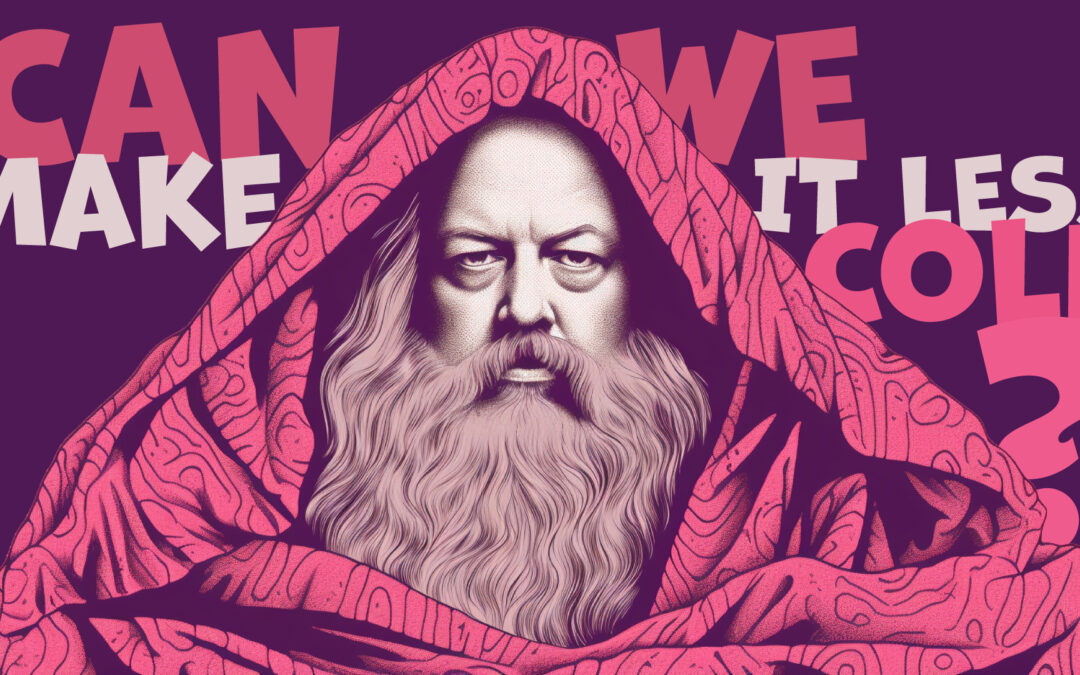“Can we make it less cold?”
I was listening to legendary record producer Rick Rubin’s appearance on the Dax Shepard podcast, and Rick uttered that simple phrase. Out loud. I could feel my body tense up, and the runaway train that is my brain was well out of the station and halfway to storyville. The immediate thought being, “Is Rick Rubin a self-entitled jerk? Cause I really want to like Rick Rubin, and if he’s a jerk that’s going to be tough.”
That’s all it took. Six simple words, “can we make it less cold?”, and I was already making up grandiose tales in my head. What followed next taught me a lot about internal storytelling and meaning making.
Here’s a bit more of the exchange from the interview, edited slightly for brevity:
Rick: “Can we make it less cold.
Dax: (immediately) Yessss
Rick: It’s just blowing right on me. I’m just coming from Costa Rica, so I’m particularly…
Dax: I applaud your lack of codependency because I would find myself freezing somewhere and I would just deal with it. I’d be too afraid you wouldn’t like me. I’m impressed by what I just witnessed.
Rick: Why do I care if you like me?
Dax: Yeah, you can advocate for yourself.
Rick: I’m here to be myself. I hope that you like me, but I’m not going to change me so you like me.
Dax: You’re not going to pretend you’re warm when you’re cold.
Rick: No.
Dax: That’s admirable — you realize most people struggle with that.
Rick: Therein lies what my job is, and what the job of creativity is: Knowing yourself, being ok with yourself, and being able to say, “It feels cold in here.” That’s all my job is […] Also, I’ve been asked, how do you have confidence in your taste? It’s like, I’m either cold or I’m not cold. It’s so clear. I’m getting chilly. I feel like there’s cold wind blowing on me. And, it has no more meaning than, “it seems cold in here.” There’s no greater meaning, there’s no insult. It’s so face value. This is what’s happening, and I’m responding to what’s happening. That’s all.
Dax: Within that is a tool, because for most people it is much more cluttered than that … it can lead to a million thoughts.
Rick: It’s true. […] I think it’s ok to talk about these things.
It is ok to talk about these things. So, let’s unpack it from a couple of angles. First, let’s acknowledge the clear boundaries established by Rick, brought to the fore with a simple and direct question. “Can we make it less cold?” Seems simple enough, but how often have we encountered something completely different. Let’s look at some all-too-common responses we might see instead:
Passive Aggressive: “I’m not really stuttering – that’s just the sound of my teeth chattering.” This gives no clear directive, no question asked, no solution suggested. Just a vague, negative comment that leaves interpretation entirely up to the recipient.
Self-Deferential: “I’m so sorry, I know I’m just a freeze baby and I don’t want to be difficult but I’m really cold and maybe if it’s not too much trouble I could get a blanket or something?” This adds so many unnecessary layers to the entire ask, usually because we are somehow ashamed or embarrassed by what is a simple, straightforward request.
The Silent Treatment: “It’s freaking cold in here. I don’t want them to think anything bad about me, they must like it cold. I’m going to suck it up and keep my mouth shut.”
What does this lead to?
Resentment — “Why the heck do they keep it so cold in here. Can’t they see I’m freezing?”.
Self-flagellation — “Why can’t I just tell them I’m cold. I’m so ridiculous, I can’t even acknowledge my own body temperature.”
Unmet needs — after all, it’s still cold!
These are just some of the responses that we experience (and let’s be honest, the responses we provide to others) on a daily basis. Note how often these responses lack the basics of positive communication: clarity, directness, honesty and kindness.
In our work, we often tee up the idea of “assuming positive intent” — in essence, while reading an email or listening to a coworker trying to anchor in our mind the base belief that the intent of their message is positive. Seems simple, right? But just like my unconscious internal response to Rick, we often do exactly the opposite. We lace everything with meaning, and not the positive kind! It’s easier to assume instead that someone is being snippy, or dishonest, or subtly attacking your intelligence, or accusing you of something you didn’t do. Simple words quickly take on a life of their own — often light years away from their actual intent.
How do we combat this? First, pause and consider how you might be concocting a false narrative. Have you ever noticed that if you go back an hour later and reread an email that it somehow doesn’t seem as bad as you remembered it? That’s because your brain has had time to process the actual message, not the story you made up in your head.
If you still aren’t sure, communicate directly. Ask for clarity — preferably in-person, face-to-face. It’s truly stunning how often issues are only issues in our own mind. Is it unclear? Go ask. Have a direct conversation. This simple tactic alone would eliminate at least half of the workplace confusion and corresponding shenanigans.
Finally, be clear on your own boundaries, needs and directives, and communicate them clearly, without additional unnecessary layering. Collectively, we can begin to “make it less cold”.

